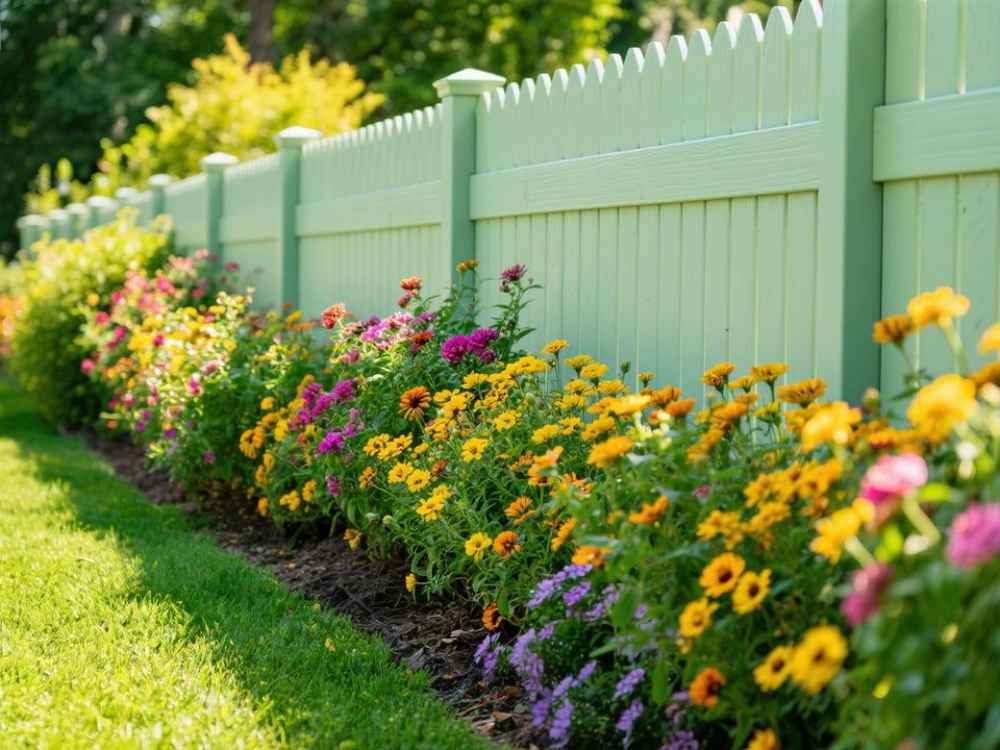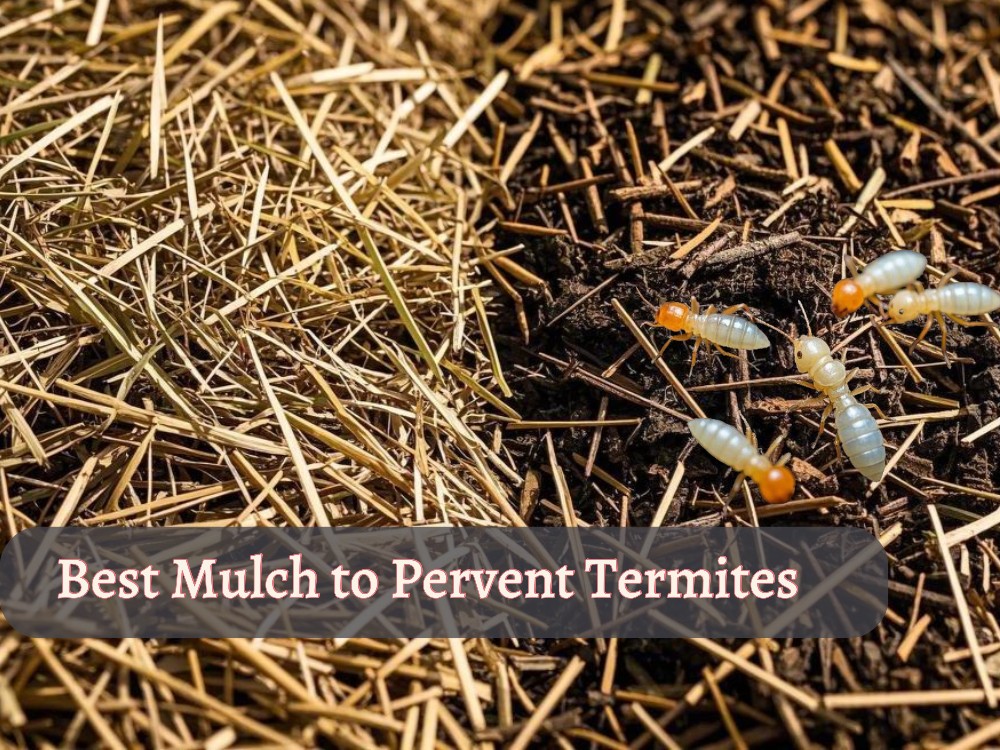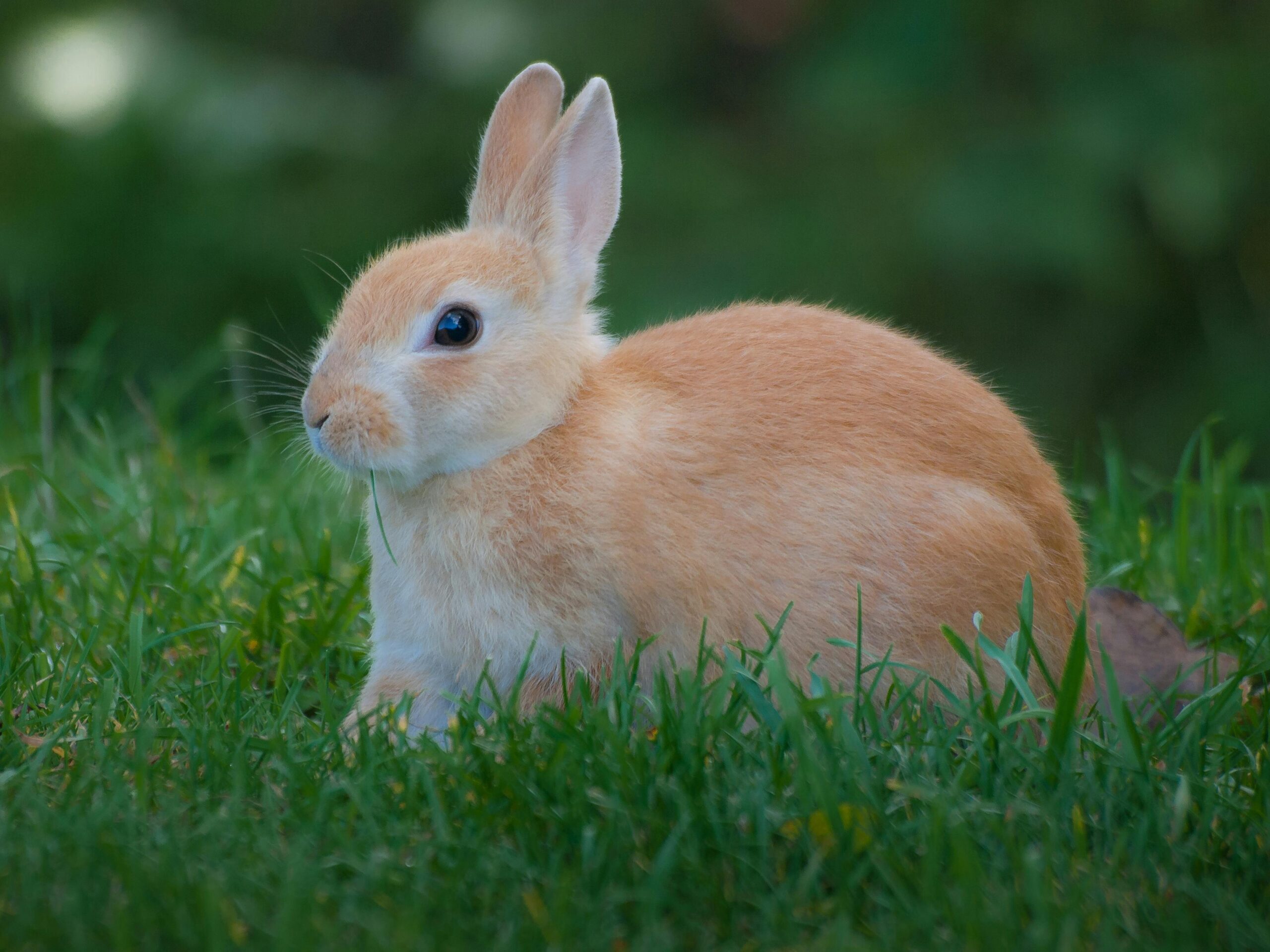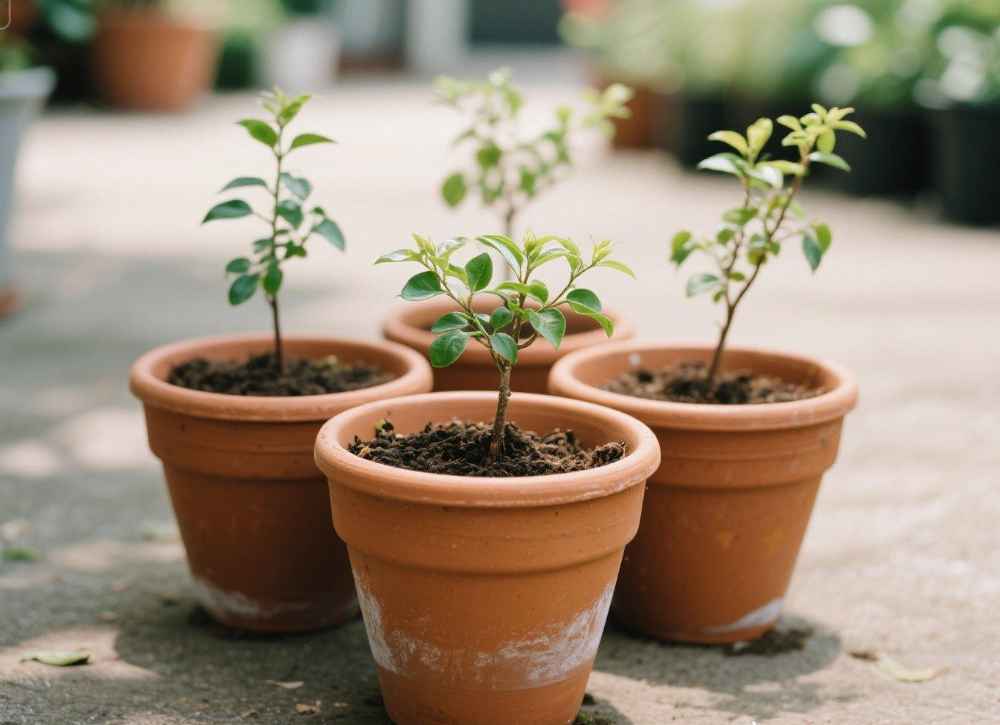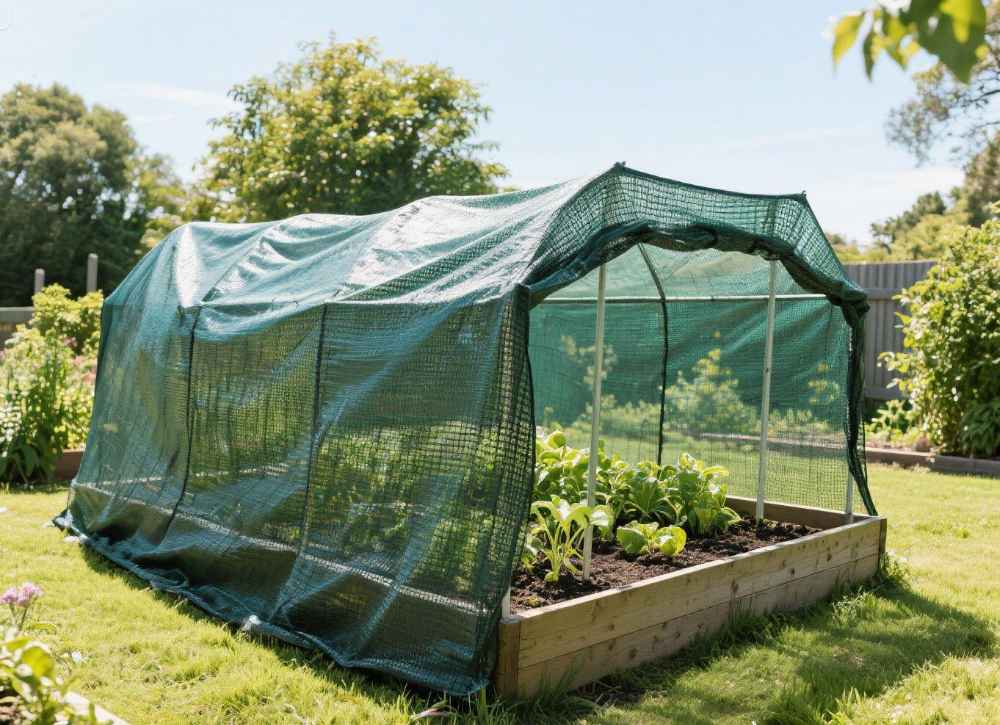Make your yard beautiful and cozy with our friendly guide on growing plants along a vinyl fence! This complete guide is for making your yard more attractive through plants while maintaining a privacy setup. And the best part? It’s easier than you think, so you can feel confident and capable of enhancing your outdoor space.
We will learn everything about enhancing vinyl fences with low-maintenance plants, from selecting the right plants to planting and maintaining them.
Modern Advantages of Vinyl Fence
Congratulations on choosing a vinyl fence for your privacy and gardening needs! You’ve made an intelligent decision. Vinyl fences offer a range of modern benefits, reinforcing your choice and instilling confidence in your decision.
Vinyl fences are durable and weather-resistant, and they require minimal upkeep. It means you can relax and enjoy your outdoor space without the burden of constant maintenance. Beyond, there is no need to remove or paint the color repeatedly. It has the permanent color you want, so your vinyl fence always appears new.
Are you interested in Landscaping? if yes, you might like this post about Landscaping Vs. Renovation for better understanding!
How to Grow Plants Along a Vinyl Fence: Benefits and Best Plant Choices
Benefits for Growing Plants Along Vinyl Fences
You want to know the advantages of growing plants for vinyl fences.
This section is mainly for beginners; here’s why we grow plants along vinyl fences;
✅Make a Beautiful Backdrop and Enhance the Overall Landscape
I have observed that plants can soften the plain look of a vinyl fence by adding greenery and colorful texture. Growing flowering plants, vines, and climbers makes your yard and backdrop more attractive and inspires a sense of excitement.
✅Maintain Privacy and Keep your garden Cozy
The second thing is the best privacy setup! Plants like shrubs or tall flowers work as natural barriers, making your outdoor space more private and peaceful. Just understand that plants become a layer along your fence to reduce the area’s visibility in sight.
✅Control Temperature, especially in the Summer Season
Growing plants along the fence helps to maintain a balanced temperature for other plants in the garden. Plants along the border provide natural shade to protect plants from intense heat and absorb the surface heat of the fence to maintain the fence temperature for long-term durability, especially during the hot summer months.
✅Work as a Sound Barrier to Reduce Noise
I had no belief, but after growing plants along the fence, the results shifted to positive. Plants’ foliage helps reduce the noise around us, making it the best sound block to make your outdoor yard peaceful and restful.
✅Attract Wildlife to Enhance its Beauty
Plants like ivy, climbing roses, and clematis attract birds, butterflies, and bees to create a lively environment. Some plants provide shields and food for various species, making your yard visually appealing and a haven for wildlife.
✅Maintain the Durability of the Vinyl Fence
Plants along the vinyl fence protect it from direct sunlight, dust, and wind. They cover your fence to maintain its durability for a long time.
✅Optimize Space for Small Gardens
Using a vinyl fence and planting climbers on it makes the vertical garden. Because plants for fence grow upward, growing more plants in a small yard is an effective way.
✅Prevent Soil Erosion and Improve its Health
Deep-rooted plants prevent soil erosion, especially in rainy areas or sloped (onda) gardens. They also improve soil structure, reduce evaporation, and increase the diversity of microorganisms.
Goals-Based Plants for Vinyl Fence For Growing Along With
If you want to get all the above benefits from the vinyl fence and plants along it, here are some top plants for a vinyl fence that are easy to grow with the above advantages.
Climbers for Full Coverage
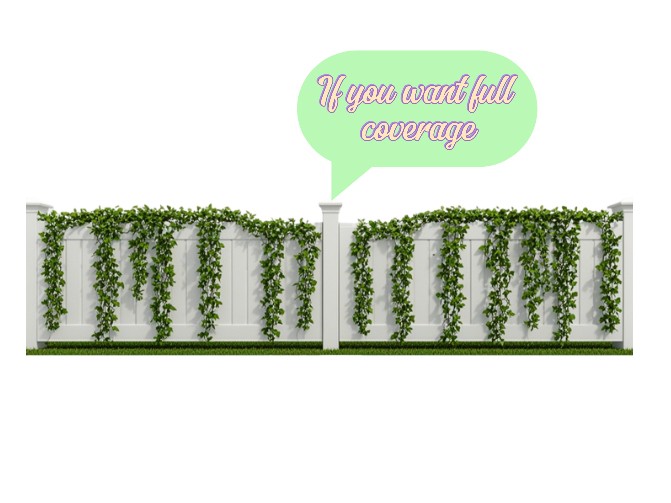
If you want full coverage and a wall effect on your vinyl fence, some climber plants will suit your needs; Tap on the name off plant to open the block!
English Ivy

A type of ivy is also known as the Hedera Helix. English Ivy is an evergreen climber that stays green every season with a mild fragrance but almost negligible. Their small and sticky roots cling easily to any surface, and their leaves are leathery dark green leaves with a glossy finish, having a heart shape with 3-5 lobes.
English ivy also produces yellow-green flowers from late summer to fall and fruits in the shape of berries after the vine matures in black or dark purple, which is toxic to humans and animals but often consumed by wildlife.
Ideal Conditions and Care Maintenance for English Ivy
| Conditions | Requirements |
| Light | Shade/Partial Sun |
| Soil | Moist, Well drained |
| Watering | Regular Deep but avoid over |
| Climate | Mild and mild |
| USDA hardiness zones | 8a to 13b |
| Fertilization | Spring Fertilizing |
| Maintenance | Trim Regularly |
Climbing Hydrangea

Climbing Hydrangea is a flowering vine or deciduous vine that sheds its leaves in winter and grows new leaves and flowers in warmer weather. They are slow-growing and climb using aerial roots that attach to surfaces, making them an excellent choice for covering fences and walls. Their mild fragrance makes the garden fresh and welcoming in summer.
Climbing hydrangeas bloom in late spring to early summer, have white or cream clusters with an icecap shape in summer, turn into yellow leaves in fall, and shed leaves in winter. Its small and greenish flowers bloom, leading to berries that can be toxic if consumed.
Ideal Conditions and Care Maintenance for Climbing hydrangeas
| Conditions | Requirements |
| Light | Partial to Full shade |
| Soil | Moist, Well-drained, Slightly Acidic to Neutral |
| Watering | Regular, Deep Watering |
| Climate | Cool, Moist Conditions |
| USDA Hardiness | Zone 4 to 8 |
| Fertilization | Light fertilization in spring |
| Maintenance | Prune After Flowering |
Virginia Creeper

Virginia Creeper is a fast-growing perennial plant, meaning it can live for more than years and regrow each spring from its roots. As a deciduous vine, it also loses the leaves in Winter but produces new growth each year. Virginia Creeper also retained the ability to climb and cover large areas with its sticky tendrils, covering the fence and creating a green, lush screen.
Another touching benefit is the color of the fall leaves of Virginia Creeper. Yes! Its red leaves add a seasonal view to your fence, making it practical for privacy. Virginia Creeper brings flowers in late spring, around May to June, depending on the climate and growing conditions. Its flowers are small and greenish, not very showy. After, they produce bluish-black berries that attract wildlife.
Ideal Conditions and Care Maintenance for Virginia Creeper
| Conditions | Requirements |
| Light | Full Sun/Partial Shade |
| Soil | Well-drained, Moist |
| Watering | Moderate, Deep but avoid over |
| Climate | Mild, Humid |
| USDA Hardiness | Zone 3 to 9 |
| Fertilization | Spring, Balanced Fertilizer |
| Care and Maintenance | Prune Regularly |
Shrubs for a Structured Look
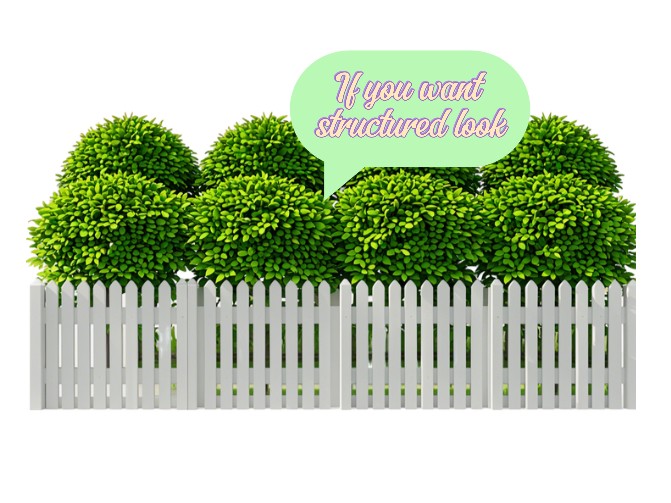
If you are thinking about a neat, structured appearance that complements the clean lines of a vinyl fence, the following shrubs stay lower to the ground, creating a tidy, cohesive border along the wall;
Boxwood Shrubs

Boxwood (Buxus) is most famous for its dense and compact structure. It is a shrub, having small, round leaves with a deep green color that remains fresh and beautiful throughout the year. Depending on variety and pruning, they can grow 2-15 feet tall, meaning that the above size is general. Still, the actual size is in your hands, which you create by pruning. They also bloom small greenish-yellow flowers arranged in clusters in the spring. Flowers on shrubs enhance the appearance of your fence and create a seasonal touch.
Boxwood is slow-growing, with a growth rate of 4 inches per year, depending on the variety and growing conditions. Its evergreen property makes it a more popular choice for vinyl fences to create strong privacy.
Ideal Conditions and Care Maintenance for Boxwood Shrubs
| Conditions | Requirements |
| Light | Partial Shade/Full Sun |
| Soil | Well-drained, Loamy, Slightly Acidic to Neutral |
| Watering | Moderate, Well-drained |
| Climate | Prefers cool climates, USDA Hardiness Zones 5-9 |
| USDA Hardiness | Zone 5 to 9 |
| Fertilization | Early Spring |
| Care and Maintenance | Prune to shape, Regular Trimming |
Dwarf Holly

Dwarf Holly is well-known for planting along vinyl fences to create a neat and evergreen privacy hedge. It can extend 4 to 8 feet tall and spread 3 to 4 feet wide, making it the perfect option for a low-maintenance hedge along the vinyl fence. Its small size ensures it won’t overpower the space, and its dense effects enhance its ability to provide the best privacy and security.
In the late spring, they also produce white and small flowers. During the fall, they convert them into black or purple berries that attract wildlife, making heaven for birds and other nature. Dwarf Holly are moderately slow-growing shrubs with an average annual growth rate of 6 to 12 inches. Their steady growth is well-suited for creating a dense, tidy hedge over time without becoming overgrown too quickly.
Ideal Conditions and Care Maintenance for Climbing hydrangeas
| Conditions | Requirements |
| Light | Full Sun/ Partial Shade |
| Soil | Well-drained, Acidic |
| Watering | Moderate, Regular |
| Climate | Mild, Humid |
| USDA Hardiness | Zone 6 to 9 |
| Fertilization | Spring and Fall |
| Maintenance | Prune Lightly |
Privet

Privet is considered part of the Olive family and is also known as a hardy shrub. Privet is often chosen for privacy hedges due to its dense foliage and ease of maintenance. Privet grows upright and makes dense hedges, reaching 10 to 15 feet tall. It doesn’t need any specific support, making it low maintenance for vinyl fences and other surfaces.
It produces small white and fragrant flowers in late spring to early summer. After flowering, blackberries appear, not only for privacy but also to attract wildlife like birds. Privet is a fast-growing plant that can reach several feet in a growing season. If you want to create a quick privacy layer, private is also the best option for your vinyl fence.
Ideal Conditions and Care Maintenance for Privet
| Conditions | Requirements |
| Light | Full Sun to Partial Shade |
| Soil | Well-drained, Loamy, Slightly Alkaline |
| Watering | Moderate; Drought-tolerant once established |
| Climate | Mild to Warm; Tolerates humid or dry conditions |
| USDA Hardiness | Zones 5-9 |
| Fertilization | Early Spring; Use balanced fertilizer |
| Maintenance | Regular pruning to shape and control growth |
Flowering Plants for Color and Fragrance
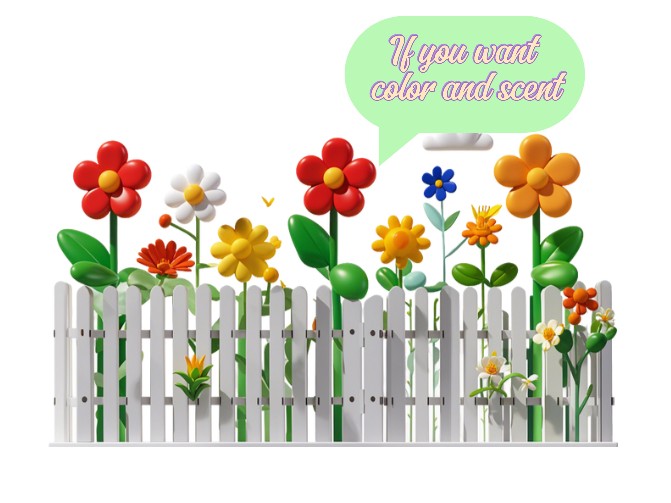
Some flowers can be planted along the wall or fence. If you want a pleasant scent and vibrant colors along the vinyl fence to make it inviting, and you want seasonal blooms that stand out against the fence’s color,
Lavender

Lavender (Lavandula) is a fragrant flower plant. Lavender is a small and woody shrub with purple flowers. It typically grows 20 to 24 inches tall and wide. Its long, gray-green leaves look great with the purple flowers that bloom in late spring to early summer.
It has a clean, simple look that fits well with old-fashioned and modern fence styles. While it doesn’t produce significant fruit, its flowers are widely used for many purposes, such as making oils and perfumes due to their fragrance.
The flowers grow in tall spikes, giving the plant a vigorous, upright appearance that complements the shape of a vinyl fence.
Lavender is a slow-growing flower with an average annual growth rate of 6 to 12 inches. While it can take a few years to mature, around 2 to 3, its steady and controlled growth can create a low-maintenance hedge or border along a vinyl fence.
Ideal Conditions and Care Maintenance for Lavender
| Conditions | Requirements |
| Light | Full Sun |
| Soil | Well-drained, Sandy |
| Watering | Low, Drought-tolerant |
| Climate | Warm, Dry |
| USDA Hardiness | Zones 5 to 9 |
| Fertilization | Trim After Blooming |
| Maintenance | Rarely Needed |
Climbing Roses

The Climbing Rose (Rosa setigera) is a rose plant. They are not true climbers! However, you must train it to climb on a fence or any other surface. With proper care, climbing roses can make any wall look elegant and full of life. With long stems reaching 3 to 20 feet tall, climbing roses are perfect for fences or walls to create a lush look and privacy. They produce flowers in many colors, like red, pink, or white, in clusters or alone. Many climbing roses bloom multiple times, from spring until late summer.
As you also know, several rose varieties produce flowers in attractive colors and shapes. Some varieties have a strong fragrance. While climbing roses is not for fruit production, the flowers may sometimes develop hips in the fall, adding a seasonal touch and attracting wildlife.
Depending on the variety and condition, climbing roses have a moderate to fast growth rate. Half the growth rate is in your hands, as proper care can enhance their development to provide a lush and colorful barrier.
Ideal Conditions and Care Maintenance for Climbing Roses
| Conditions | Requirements |
| Light | Full Sun (6+ hours/day) |
| Soil | Well-drained, Loamy, Slightly Acidic |
| Watering | Regular, Deep but avoid over |
| Climate | Mild, Moderate |
| USDA Hardiness | Zone 5 to 9 |
| Fertilization | Early Spring, Monthly during Growing Season |
| Maintenance | Prune Annually, Remove Deadwood |
Clematis

Clematis is stunning for its climbing ability and vibrant flowers, making it the ideal choice for your vinyl fence to create privacy from its climbing ability and a lush, beautiful look with its vibrant flowers. It has more than 300 species, such as Clematis Vitalba.
Clematis is a climbing vine that can grow 10 to 80 feet, but stop! It depends on the type you are using. It has thin, delicate leaves and large, bright flowers in different colors, such as white, purple, blue, and red. These plants climb using small parts of their leaves to hold onto fences or walls.
Clematis is widely used for its large, colorful, and star-shaped flowers, which bloom from spring to summer, depending on the species. It can also produce tiny seeds, but there are other reasons for planting it. Clematis are fast-growing, with an annual growth rate of 3-10 per year. Remember! Everything depends on environmental conditions and care. With proper care, they can quickly cover your vinyl fence.
Ideal Conditions and Care Maintenance for Clematis
| Conditions | Requirements |
| Light | Full Sun to Partial Shade |
| Soil | Well-drained, Moist, Slightly Alkaline |
| Watering | Regular Deep but avoid over |
| Climate | Cool to Moderate |
| USDA Hardiness | Zone 3 to 9 |
| Fertilization | Prune after flowering, Trim dead growth |
| Maintenance | Spring and Summer |
How to Grow Plants Along Vinyl Fence?-Best Strategy

Let’s return to your topic and query: ” How to grow plants along vinyl fence.” You might have discovered some plants for vinyl fences that match your goals. But how to grow it? Let’s find;
How to Grow Plants Along Vinyl Fence: Step-By-Step
Planting climbers, shrubs, or hanging flowers along a vinyl fence is easy. Just make sure you are ready for that!
✔️Select the Right Plant According to Your Goals
The first step is crucial to seeing the results you want. For instance;
- If you wish full vinyl fence coverage, select English Ivy, Climbing Hydrangea, Virginia Creeper, or others.
- If you like structure, look at the base of the vinyl fence; shrubs like Boxwood, Privet, and Dawrf Holly are the best options.
- Flowering plants such as lavender, climbing roses, clematis, or others will be suitable to add color and a pleasant scent.
All plants for vinyl fences offer different privacy setups based on their structure, appearance, and variety. And environmental factors affect plant growth traits, so choose the right plant according to your climate to maintain plant growth.
✔️Prepare the Place and Soil
Next, consider where your face is placed and prepare the soil along the base of the fence by removing weeds and debris.
- How pH? Keep the soil pH according to the plant you choose. Scroll up to the pH range of the plant you want to grow along your vinyl fence.
- Losen the soil by using a garden fork to make accessible space for spreading plant roots.
- Fertile the soil with organic compost after checking soil pH. Make sure to add a suitable amount of fertilizer according to soil acidity.
Remember that the soil should be well-drained, not waterlogged, to reduce the risk of rotting in plant roots.
✔️Setup support for Climbing plants
Climbing plants require support to grow vertically, so install support structures like trellises, poles, or wires before planting.
- Ensure the support is sturdy enough to hold the plant as it grows.
- Also, it should be positioned to allow easy access for watering and maintenance.
- Check regularly and train it in your desired direction.
By the way, many vines claim naturally, but you may need to encourage them gently.
✔️Sow your chosen plant.
Now, take the plant seed or cutting and sow it in the soil. Correctly planting ensures the plants will grow strong and healthy. Just consider two things;
- Spacing: Give space plants based on their expected size
- Space the 6 to 12 inches from the fence for climbing plants.
- Shrubs need more space, depending on the maturing size.
- Depth: Place each plant at the same depth it was in its nursery container. Avoid planting too deep as it can cause rotting.
Before planting, dig holes in the root ball size, and after planting, leave water to settle the soil around the roots and reduce transplant shock.
Each plant requires different environment and conditions for both propagation; vegetative and non-vegetative! If you are trying cutting propagation, maintain ideal situations for it! Explore the ideal environment. Don’t know which plant is suited for which cutting propagation type? Here’s discover plant’ ability for cutting propagation. Or if your plant is famous for layering propagation, try it also!
General Care and Maintenance For Plants along the Vinyl Fence
However, I have already described care tips for every plant in the article. Still, there is also a general and practical guide for care and maintenance. Still, if your plants aren’t thriving in their in environment, here can be some hidden reasons!
🗸Watering and Fertilizing
Watering➔Many plants are low-maintenance and drought-tolerant, but occasionally, watering is essential when soil or weather conditions are too dry. Avoid over-watering as it stresses plants.
Fertilizing➔Feed your plants with a balanced fertilizer in the spring. Summer may be good, but avoid overfertilizing as it can harm your plants. Use organic fertilizer according to your soil pH, like;
- Suppose your soil is acidic, and your chosen plant prefers natural soil. In that case, it may be best to use calcium carbonate!
🗸Mulching and Pruning
Muching➔Apply a mulch layer around the base of plants, but leave some space around the plant’s stem to prevent moisture buildup. Use organic mulch (like wood chips or shredded leaves) to retain moisture, regulate soil temperature, and suppress weeds.
Pruning • While your plants along the fence can grow onto your vinyl fence, pruning becomes essential. Cut damaged and dead branches to encourage its new growth and give it a neat appearance.
🗸Control Pests and Diseases
Pest • Regularly check plants, as common pets like aphids, snails, and caterpillars can attack plants. Home remedies or biological methods are used to control them.
Disease➔Many plants can also suffer from diseases like white rot, mildew, mold, or rust. Keep the soil clean and allow for proper air circulation to prevent these.
🗸Maintain Fence Condition
While vinyl fencing requires minimal maintenance, it ensures it stays clear for plant growth. Lastly, check that plants are not pushing against the fence, which can cause damage over time.
Also, occasionally clean the dirt on the vinyl fence to remove dirt and algae buildup, which could affect the appearance of the plants nearby.
🗸Seasonal Care
According to USDA hardiness zones, each zone’s climate is different according to its minimal winter temperature so that the growing season can be short or long based on climate conditions.
Discover your zones here and adjust everything according to them. You can also explore our category gardening by zones, which includes 11 zones. Explore the zone category that you have!
🗸Protect Plants from Winter
Many plants can not tolerate too much frost, so they are covered with burlap or row covers to shield them from harsh winter conditions. Here is the complete guide for protecting garden from winter!
Final Thoughts-How to Grow Plants Along Vinyl Fence
So, there’s no need to wonder ‘how to grow plants along a vinyl fence’ anymore. Explore plants that thrive in vinyl fence conditions and follow specific care guidelines. You’ll create a stunning, lush privacy screen by considering the right plants and maintaining them properly.
If you have any questions, feel free to leave a comment below. Let’s grow the perfect green space together
